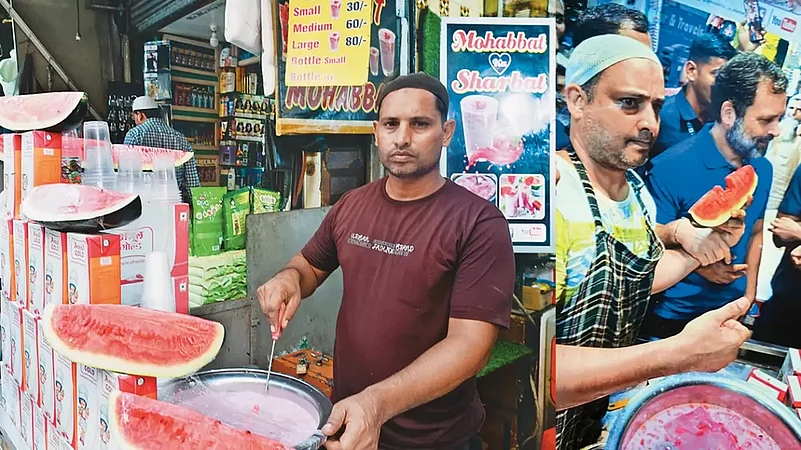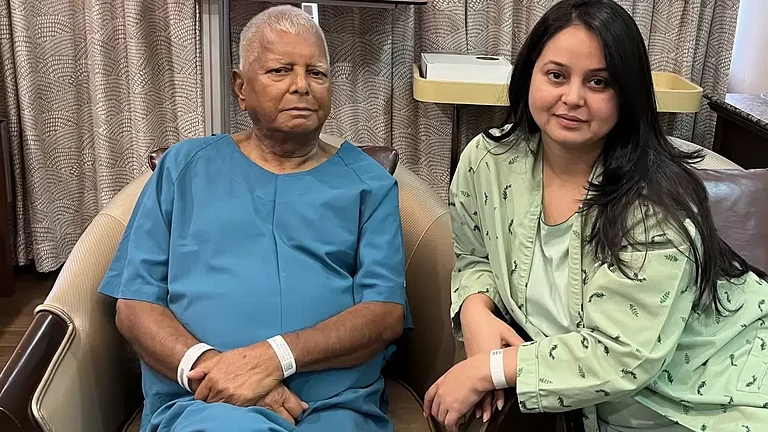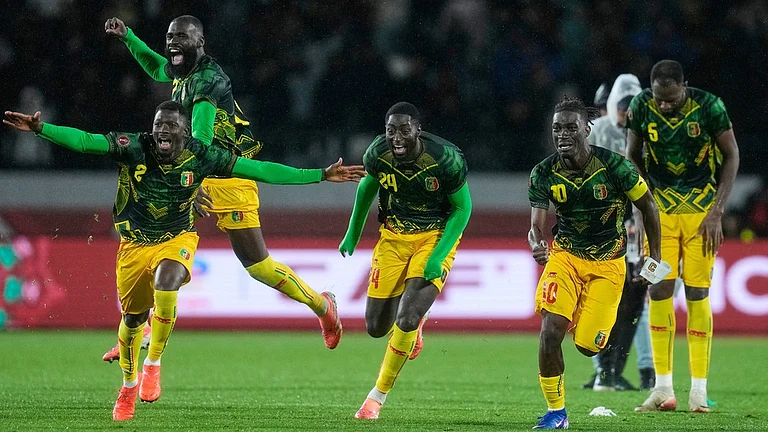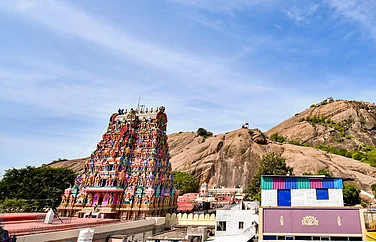For years, Danish Ahmed, 46, has been running a sharbat shop in one of the lanes opposite the historic Jama Masjid in the capital that serves a very special sharbat. But only recently the nondescript shop became the talk of the town when Congress leader Rahul Gandhi made a pit stop here to have the famous mohabbat ka sharbat—a popular summer drink made of fresh watermelon, rose syrup, milk sugar, ice cubes and rose petals.
“This is the bench where he sat,” says an enthusiastic Ahmed while showing photos and videos of Gandhi. When asked what the most memorable aspect of his visit was, he says: “His statement ‘nafrat ke bazaar me hum mohabbat ki dukan kholenge’, has stayed with me.”
For Ahmed, love is bhaichara—a sense of brotherhood among different communities, which is significant in the present atmosphere of pervasive hatred. “Love is like our sharbat—pure and authentic. It spreads faster than any other emotion,” says the sharbat maker.
The statement made by Gandhi at the juice shop was the central theme of his more than thousand kilometre-long Bharat Jodo Yatra in 2022-23 in which he, along with thousands of others, walked from Kanyakumari to Kashmir. Addressing a rally at Nuh in Haryana in January, Gandhi said: “When these people go out to spread hatred in this country, people of our ideology go out to spread love and affection”.

Love is not just an emotion; it has revolutionary potential embedded within it. Russian revolutionary Alexandra Kollontai’s conceptualisation of love as a ‘social emotion’ that ‘possesses a uniting element which is valuable to the collective’ somehow gets lost when hatred becomes an everyday reality. For instance, in Karnataka—a state where the Congress party won the recent Assembly elections—as per media reports, 105 First Information Reports (FIRs) had been filed against hate speech between January 2020 and January 2023. The growing attacks against journalists and political opponents also testify to the prevalence of hatred. Reporters Without Borders, an organisation that monitors the condition of freedom of speech and expression across the globe, ranks India 161 among 180 countries. As per the National Crime Records Bureau (NCRB), between 2017 and 2021, 2,908 cases of communal or religious rioting were reported in the country.
When Dalits are flogged for simply sporting a moustache or riding a horse; instances of upper caste men urinating on Adivasis come to light and people are lynched for refusing to chant Jai Shree Ram; love seems to be the biggest casualty of hate-driven politics. But what does this ‘shop of love’ in the ‘market of hate’ mean? Does it have a larger connotation? Can it be a counter-emotion against the unabated hate?
Bhaichara as a Civilisational Ethos
Congress leaders think that Gandhi’s message of love appears to be emancipatory and refreshing. “In the past few months, the political perspective of the country has thoroughly changed. The BJP (Bharatiya Janata Party) came to power tapping on the idea of hatred to communalise people. But, Gandhi’s message of love has made it weak,” says Ariba Khan, a young Congress leader and a councilor of Municipality Corporation of Delhi (MCD).
Being one of nine Congress representatives who survived the debacle of the party in the MCD polls, Khan reads a commendable transition through it. “Muslims have always been with the party. For some time, they went away, but again they have come back with the message of bhaichara,” she says. Notably, among the nine seats that the Congress won in the MCD, seven are from Muslim-dominated localities. “The hatred may sustain for sometimes but negative emotions cannot win,” she adds.
Asif Mohammad Khan, a senior Congress leader and former Member of the Legislative Assembly (MLA), points out that the idea of bhaichara has been a part and parcel of Indian culture. “In this subcontinent, we have always believed in the Ganga-Yamuna civilisation. In Parliament, Muslim issues have always been raised by Hindus.” The hatred that the BJP tried to spread will not last for long, he adds.
In reference to the Sri Lankan unrest, he says: “The environment of hatred peddled by the government ultimately engulfed them.” So, the sustenance of hate is merely a matter of time before it becomes Frankenstein. Gandhi’s message of love is his reflection on such civilisational behaviour, notes the senior leader. Perhaps these civilisational values made Gandhi realise the essence of Bharat and its multifaceted trajectories of love filled with the stories of Babur-Baburi, Krishna-Radha or Meghnad and Sulochana.
A Yatra Against Hate
The significance of Bharat Jodo Yatra in spreading Gandhi’s words of love across the country is undeniable. During the Yatra, Gandhi’s message of love was not limited to the words. His affectionate cuddling with his sister Priyanka Gandhi Vadra and his adorable photos with Rajasthan MLA Divya Maderna had some subtle connotations. In contrast to the masculine chest-thumping and muscle-flexing, it was soothing. “There was no 56-inch chest thumping. He was brother and friend to everybody. It was a spectacle, but of a different kind,” notes a political analyst on the condition of anonymity.
His connection to his grandmother Indira Gandhi who was killed when Gandhi was just 14 also struck a chord. As the Yatra entered Delhi, Gandhi tweeted: “The love that I got from her, I am sharing the same with the country.”
Love and care as a central component of Gandhi’s message were reflected throughout his speeches. In one of his addresses, he said, “In Bharat Jodo Yatra, dogs also came but no one harmed them. Cow, buffaloes, pigs, all animals came. All the people came. This Yatra is like our India, I have not seen any hatred or violence among people while walking, and I have not seen violence or hatred anywhere in the country. But when I turn on the TV, there is hatred all the time. Twenty-four hours there is only Hindu-Muslim in the media.”
In the words of Gandhi, the Yatra taught him the essence of humbleness. It gave him the patience to hear the voices of the people who still believe in the power of love and empathy. “When I started from Kanyakumari, I was arrogant. I was fit. I could run 12-odd km regularly. How hard could walking 25 km be, I thought? I was humbled. Bharat Mata whispered an instruction—don’t be arrogant. I obeyed and I could find strength to walk. I used to speak a lot at the start of the yatra, but slowly, I started listening more. And then words became redundant … people would come and hug me, or embrace me, or shake hands. As hands met hands, hearts would meet too, and words were not needed,” he said.
This learning perhaps made him think through the insecurities of people. Maderna, whose photo with Gandhi was taken up by the troll army to demean the ‘bachelor’ Gandhi scion, says: “There is a certain amount of insecurity among every citizen. In every sector, from Journalism to education, you can find people feeling unsecured.” Gandhi spoke about the issues that affect them. Issues like price rise, inflation and unemployment were discussed, not hatred, polarisation and divisiveness, she adds.
The positive impact of the Yatra, she notes, could be felt in Karnataka. “When people get the sense of security from a party, they cling to it. This not only happened in Karnataka, but will happen in poll-bound states like Madhya Pradesh, Chhattisgarh and Rajasthan,” says the young MLA.
Love as Counter-emotion
The connection between love and freedom could be found in American Black scholar James Baldwin’s celebrated work Giovanni’s Room that has currently become a testimony of love for the LGBTQIA community. American author Bell Hooks while speaking about love as an emotion, says: “Love is a combination of care, commitment, knowledge, responsibility, respect and trust.” Hooks finds the meaning of love beyond its perceived ambit. Thai social activist Sulak Sivaraksa expands the meaning of love to “help build a more non-violent world”. In all of these instances, love is multidimensional—sometimes becoming resistance and in other times a source of emancipation.
While Gandhi’s emphasis on mohabbat has been found to foment a counter-emotion against the prevalence of hate; far from its context, a Shah Rukh Khan-starrer film Pathaan became an opportunity for people to show resistance through their love for the superstar.
The social media campaigns against the film by the Right-wing organisations couldn’t deter its popularity. The film has already earned $130 million from across the world—a record-breaking income in the recent times. The earlier controversies over the saffron-clad Deepika Padukone though worked at the surface level leading to the calls for boycott, it certainly failed to affect the popularity of Khan. The crowds twisting to the tune of a peppy song as the credits rolled over the silver screen made it clear that the common people hardly bought into the narratives of hatred.
Given the continuous attacks on Khan by the social media troll army in recent years, it was expected that Pathaan would evoke polarised emotion. However, love for Khan triumphed over the prevailing hate. But where does this hate for Khan come from?
Film scholar Sayandeb Chowdhury, in one of his articles, notes: “Because SRK had to be pulled down from the talisman of being a Muslim megastar in a Hindu-majority nation.” The image of a Muslim becoming the badshah of Hindu hearts is the last thing that the saffron brigade can accept. Even though the film depicts nothing more than a masculine nationalism, the Muslim character of Pathaan—brought up by an Afghan family—and saving the country from international terrorists don’t conform to the imagination that believes in a saviour Adipurush—always embodied in a saintly Hindu figure.
Another major reason of such distaste, though rarely cited, was the presence of Padukone as the lead actress. Her presence at the Jawaharlal Nehru University (JNU) in 2020 showing solidarity with the violence-affected students was not received well by the right-wing forces. So, the presence of Khan and Padukone together was nothing more than sheer blasphemy for their social media army.
In this backdrop, the way Pathaan became a repository of love for Khan’s fandom, signifies the potential of love as resistance. To quote Chowdhury: “Pathaan has successfully propagated a masculine state, but also bandied for a country in need of healing. That the public embraced this message, participated in the cheekiness of an imaginary cinematic republic, held aloft a dimpled (and greying) hero and danced with Pathaan all the way shows the nation may not be ready to let the warm waters of the Indian popular become amenable to the cold wishes of a hawkish state.”
However, the affection for the film and the acceptance of a Muslim hero saving the nation didn’t spill out of the silver screen. According to a media survey, released on the same day as Pathaan, 53 per cent of Indians believe that Muslims indulge in love jihad.
So, the message of love rarely has space beyond the four-walls of cinema halls. One of the BJP supporters, without revealing his name, says: “Pathaan is a propaganda where they tried to show a Muslim hero saving the country. This is all that the Khans do.”
The hatred is perhaps so deep-rooted that no sharbat-e-mohabbat can heal it. Still, the hope lies in the wartime love stories. When one reads Heather Morris’s The Tattooist of Auschwitz and finds Lale Sokolov, prisoner no 32407 madly in love with Gisela Fuhrmannova, prisoner no. 34902 in the Jewish concentration camp, the essence of love survives.
Love doesn’t have big history. It survives the onslaughts of everyday hatred and violence. Still, it evokes empathy and solidarity. Nawab Qureshi, who claims to be the inventor of sharbat-e-mohabbat, while talking about the history of its nomenclature, is perhaps right when he says: “I started selling the sharbat with love and named it pyaar ka sharbat-mohabbat ka sharbat. Ye aise hi ban gaya.” Love creates history. Unfortunately, so does hatred.



























